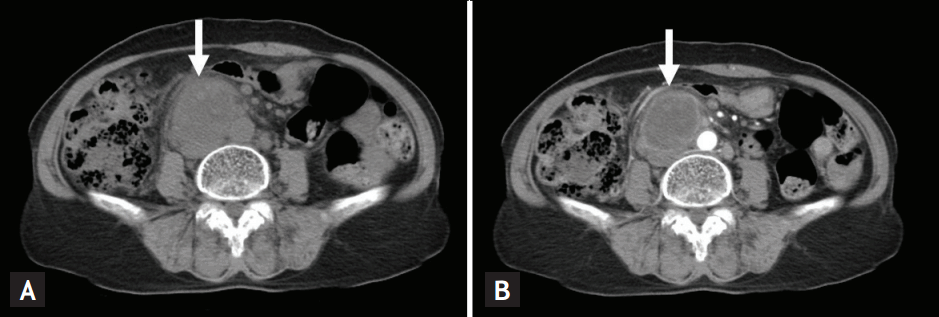 |
 |
| Korean J Intern Med > Volume 32(2); 2017 > Article |
|
A 71-year-old woman presented with a 2-week history of abdominal and back pain. She had undergone right radical nephrectomy about 2 years ago due to renal cell carcinoma. Computed tomography (CT) scans of the abdominopelvic area revealed enhancing masses with prominent necrotic change in the aortocaval and left paraaortic spaces, which were about 7.4 and 1.5 cm in size, respectively (Fig. 1). After full evaluation, she was diagnosed with recurrent renal cell carcinoma with multiple lymph node metastases and she received palliative chemotherapy with weekly temsirolimus (25 mg intravenous injection over 1 hour). The initial treatment plan was that chemotherapy would be continued until disease progression or development of an unacceptable side effect, and she received repeat chemotherapy due to best response with partial remission without any serious side effects. At 80 weeks after treatment, CT scan of the abdominopelvic area showed newly developed internal calcification in and around the aortocaval and left para-aortic areas, which was considered as dystrophic calcification during treatment (Fig. 2). The calcified metastatic lymph nodes showed no significant interval change, and the patient is alive with palliative chemotherapy at 157 weeks after being diagnosed with recurrence.
Dystrophic calcification occurs in degenerated or necrotic tissues with normal serum calcium levels, and it can be associated with a wide variety of neoplastic and non-neoplastic conditions. Epithelioid, mesenchymal, lymphoid, and germ cell tumors are malignant etiologies of dystrophic calcification. Calcifications may be primary or may arise during treatment. Although calcifications during treatment are frequently associated with disease progression, some types of malignancies such as gastrointestinal stromal tumor, non-HodgkinŌĆÖs lymphoma, and HodgkinŌĆÖs disease show response to treatment in the form of calcifications. Herein, we report a case of dystrophic calcification during palliative chemotherapy in a patient with recurrent renal cell carcinoma who showed a long term response to treatment.
Figure┬Ā1.
Computed tomography scans of the abdominopelvic area (A, precontrast; B, postcontrast) revealed an enhancing mass with prominent necrotic change in the aortocaval space, which was about 7.4 cm in size (arrows).

Figure┬Ā2.
Computed tomography scan of the abdominopelvic area showed newly developed internal calcification in and around the aortocaval and left para-aortic areas, which was considered as dystrophic calcification during treatment (A, 80 weeks after treatment; B, 157 weeks after treatment) (arrows).

-
METRICS

-
- 0 Crossref
- 0 Scopus
- 7,585 View
- 126 Download
- Related articles
-
Tracheobronchial calcification in a patient treated with warfarin2022 September;37(5)



 PDF Links
PDF Links PubReader
PubReader ePub Link
ePub Link Full text via DOI
Full text via DOI Download Citation
Download Citation Print
Print


